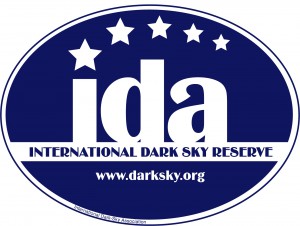Namibia is famous in astronomy circles as being an excellent location for viewing the night sky. In part this is because it is cloud-free for much of the year and its extremely dry air does not absorb much light so the stars, especially those close to the horizon, shine more brightly than they do in most places. An equally important factor is that in those parts of the country far removed from urban areas, such as the NamibRand Nature Reserve, there is still almost a complete absence of exterior lights, the main source of light pollution. To keep the sky as dark as possible, NamibRand has undertaken improvements that include eliminating as many lights as possible, and shielding others so that their light does not reach the sky. This has resulted in an extremely dark sky, allowing thousands of fainter stars to be seen and making the Reserve one of the best places in the world to observe the night sky.
On nights when the Moon does not interfere, the Milky Way, the disk of our galaxy, stretches brightly across the sky, streaked by dark lanes of dust. Two smaller neighboring galaxies, the Magellanic Clouds, are easily seen at certain times of the year as is the fainter but much larger and more distant Andromeda Galaxy. A pyramid of light rises from the west after sunset and a similar one appears in the east before dawn. This is the zodiacial light, sunlight reflected off dust located in space between the Earth and Mars. Among the stars, from time to time meteors flash across the sky. They are small pieces of rock or metal burning up as they enter the Earth’s atmosphere. After sunset and before dawn satellites, including the International Space Station with its crew of astronauts, are visible passing overhead.
Views of this magnificent sky inspire awe and wonder in modern people, just as they did in their distant ancestors who devised myths and legends to explain what they saw. A perfect stopover for astro tourism, while supporting conservation of this delicate and beautiful piece of our own planet. For affordable accommodation offerings, click here.
24 May, 2012. Namibia’s NamibRand Nature Reserve, one of Africa’s largest private nature reserves, has expanded its conservation role to include preserving the star-filled nighttime skies that shine above its dunes and mountains. These efforts in night sky conservation have earned the reserve high honors as the International Dark-Sky Association (IDA) has just announced that NamibRand Nature Reserve is the world’s newest International Dark Sky Reserve.
The International Dark-Sky Association’s night sky conservation efforts include working with groups to form International Dark Sky Reserves (IDSR) and other dark sky places. International Dark-Sky Association’s Executive Director Bob Parks explains, “The night sky over the NamibRand Nature Reserve is exceptional, as are the efforts the reserve has taken in modifying its lighting for the sake of its wildlife and visitors.”
Dr. George Tucker, a retired professor of physics from the USA, who identified the NamibRand as a potential Dark Sky Reserve and led the certification effort, says “Viewing the pristine night sky over the NamibRand is an unforgettable experience. Being recognized as a Gold Tier International Dark Sky Reserve will serve to promote and protect this valuable resource. Achieving this status is a significant accomplishment not just for the NamibRand, but also for Namibia and all of Africa.” Gold Tier is the term used to describe reserves with nighttime environments that have little to no impact from light pollution and artificial light. NamibRand’s nearest neighboring communities are small and lie some 60 miles distant, so the reserve’s sky is one of the darkest yet measured.
